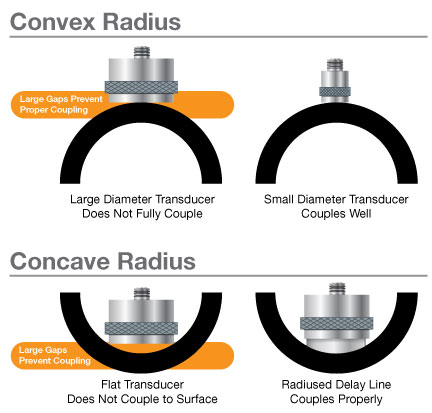探头选择
Selection of the proper transducer is an essential factor for ensuring optimum performance in any ultrasonic gauging application. It is necessary to consider the material being measured, the range of thickness that must be covered, part geometry, and part temperature. A wide variety of transducers with various acoustic characteristics have been developed to meet the needs of industrial applications. Typically, lower frequencies of 2.25 MHz and below will be used to optimize penetration when measuring thick, highly attenuating, or highly scattering materials, while higher frequencies of 5 MHz and above will be recommended to optimize resolution in thinner, non-attenuating, non-scattering materials.
Material: The type of material and the range of thickness being measured are the most important factors in selecting a gauge and transducer. Many common engineering materials including most metals, ceramics, and glass transmit ultrasound very efficiently and can easily be measured across a wide thickness range. Most plastics absorb ultrasonic energy more quickly and thus have a more limited maximum thickness range, but can still be measured easily in most manufacturing situations. Rubber, fiberglass, and many composites can be much more attenuating and often require high penetration gauges with pulser/receivers optimized for low frequency operation.
Thickness: Thickness ranges will also dictate the type of gauge and transducer that should be selected. In general, thin materials are measured at high frequencies and thick or attenuating materials are measured at low frequencies. Delay line transducers are often used on very thin materials, although delay line (and immersion) transducers will have a more restricted maximum measurable thickness due to potential interference from a multiple of the interface echo. In some cases involving broad thickness ranges and/or multiple materials, more than one transducer type may be required.
Geometry: As the surface curvature of a part increases, the coupling efficiency between the transducer and the test piece is reduced, so as radius of curvature increases the size of the transducer should generally be decreased. Measurement on very sharp radiuses, particularly concave curves, may require specially contoured delay line transducers or non-contact immersion transducers for proper sound coupling. Delay line and immersion transducers may also be used for measurement in grooves, cavities, and similar areas with restricted access.

Temperature: Common contact transducers can generally be used on surfaces up to approximately 125° F or 50° C. Use of most contact transducers on hotter materials can result in permanent damage due to thermal expansion effects. In such cases, delay line transducers with heat-resistant delay lines, immersion transducers, or high-temperature dual element transducers should always be used. See section 7.1 for further information on high-temperature measurements.
In general, the most reliable and repeatable results will be obtained with the highest frequency and smallest diameter transducer that will gave adequate performance over the thickness range to be measured. Small diameter transducers are more easily coupled to the test piece and permit the thinnest couplant layer at a given coupling pressure. Furthermore, higher frequency transducers produce signals with faster rise times, thereby enhancing measurement accuracy. On the other hand, the acoustic properties or surface condition of the test material may require that transducer frequency be lowered to overcome poor coupling and/or sound attenuation or scattering within the material.
Corrosion applications are a category in themselves, normally handled with dual element transducers. Duals are typically rugged and able to withstand exposure to high-temperatures and are highly sensitive to detection of pitting or other localized thinning conditions. However, they are generally not recommended for precision gauging applications because of the possibility of zero drift and timing imprecision due to the trigonometric correction required by the v-shaped sound path that they generate.
Some general recommendations for transducers that can be used for common materials and thickness ranges can be found in the Appendices Section.